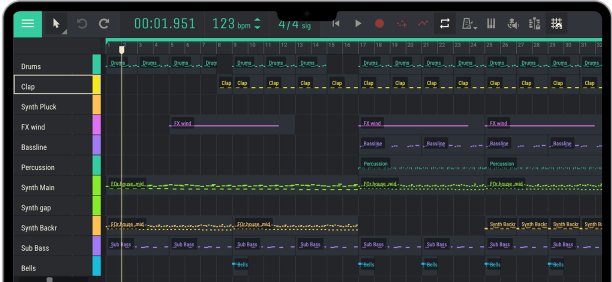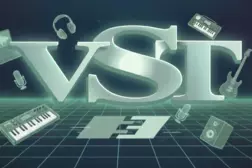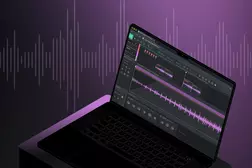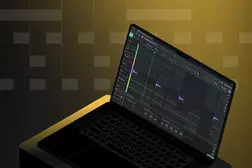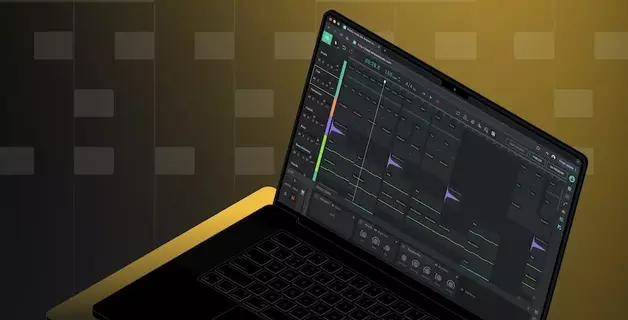How To Make House Music: A Beginner’s Guide

House music isn’t just a genre — it’s a cultural movement that changed how we think about dance music. Born in early 1980s Chicago from the ashes of disco, house emerged when Black, Latino, and LGBTQ+ communities refused to let the dancefloor die. Armed with affordable drum machines and samplers, DJs at clubs like The Warehouse stripped disco down to its pulsing core: a steady four-on-the-floor kick, soulful vocals, and hypnotic grooves. What they created became the blueprint for nearly every electronic dance music genre that followed.
Today, making house music is more accessible than ever. You don’t need an expensive studio or hardware — just a browser and some creative energy. This guide will show you how to make house music through basic steps and techniques that capture that timeless groove.
The Many Flavors of House
House has evolved into dozens of distinct subgenres, each with its own character. Deep houseemphasizes soulful vocals and atmospheric chords, pioneered by artists like Larry Heard and Kerri Chandler. Tech housestrips things down to hypnotic, minimal grooves perfect for late-night club sets. Progressive house builds epic journeys with layered synths and emotional crescendos.
Then there’s Acid house, defined by the squelchy TB-303 basslines that fueled UK rave culture in the late 1980s and influenced the emergence of another core EDM genre — Detroit Techno. French house brought disco-sampling brilliance through Daft Punk and Cassius, while Afro house infuses African percussion and rhythms into the traditional house music framework. Each subgenre shares the same DNA — that steady pulse, repetitive groove, and carefully layered arrangement — but expresses it differently.
Essential House Music Elements
Every house track shares certain fundamentals. Understanding the elements of house music will help you construct tracks that feel authentic, regardless of which subgenre you’re exploring.
- The foundation is always the four-on-the-floor kick drum — a bass drum hitting on every quarter note beat at 120 to 130 beats per minute (BPM).
- Chords in house music mostly tend toward warm, analog textures. Think electric pianos, organ chords, and synth pads playing jazzy chords. The trick is to keep it simple, yet groovy. Two or three chords that work really well together is all you need.
- The bassline provides the rhythmic glue, with syncopated patterns that interlock with the drums and create that signature push-pull groove.
Building Your House Beat
Let’s start with drums — the heartbeat of any house beat. The kick, together with the bass, is arguably the most important element of a house track, driving the groove on the dancefloor.
Open the Drum Editor and place kick drum hits on each quarter note. This four-on-the-floor pattern is non-negotiable when you make house music.
Next, add your snare and/or clap on beats 2 and 4.
Place open hi-hats on the off-beats between kicks to give your beat that signature bounce. As for closed hi-hats, there’s no strict rule: they can play a steady pulse or provide variation.

Here’s a simple example progression that screams house:
- Start with Fm7: Play F, Ab, C, then add Eb on top, which instantly makes the chord sound more sophisticated.
- Move to AbM7: Play Ab, C, Eb, then add G on top. This creates a jazzy contrast to our first chord.
- Find your rhythm: Let each chord ride for 4-8 bars, or introduce the second chord as a brief variation before the loop restarts — both are classic house moves.
Or skip the chord-building math entirely and use Amped Studio’s Chord Creator to build progressions in just a few clicks. For the instant house vibe, focus on the m7 (minor 7th), M7 (major 7th), 6, and 9 chord variations — the jazziest, most soulful options. The Chord Creator keeps everything in key, so you can experiment freely without worrying about hitting wrong notes.
Crafting a House Bassline
A good house bassline doesn’t just sit under the beat — it talks with the drums and chords. Syncopation is key — bass notes in between the kicks — but that doesn’t mean every note should be off-beat. Most house basslines balance anchored notes on downbeats (counts 1, 2, 3 and 4) with syncopated hits in between them, creating the push-pull that makes people move.
Keep your notes short and percussive. Start simple: a root note after beat 1 and another on beat 3. Then, try adding a note on the “and” of 4 to lead into the next bar (if we count beats in a bar as 1-and-2-and-3-and-4). For variation, experiment with octave jumps and chromatic steps — sliding up or down by a single semitone (for example, if we are in the key of F minor, brief sounding E sliding into F will be an example of a chromatic step).
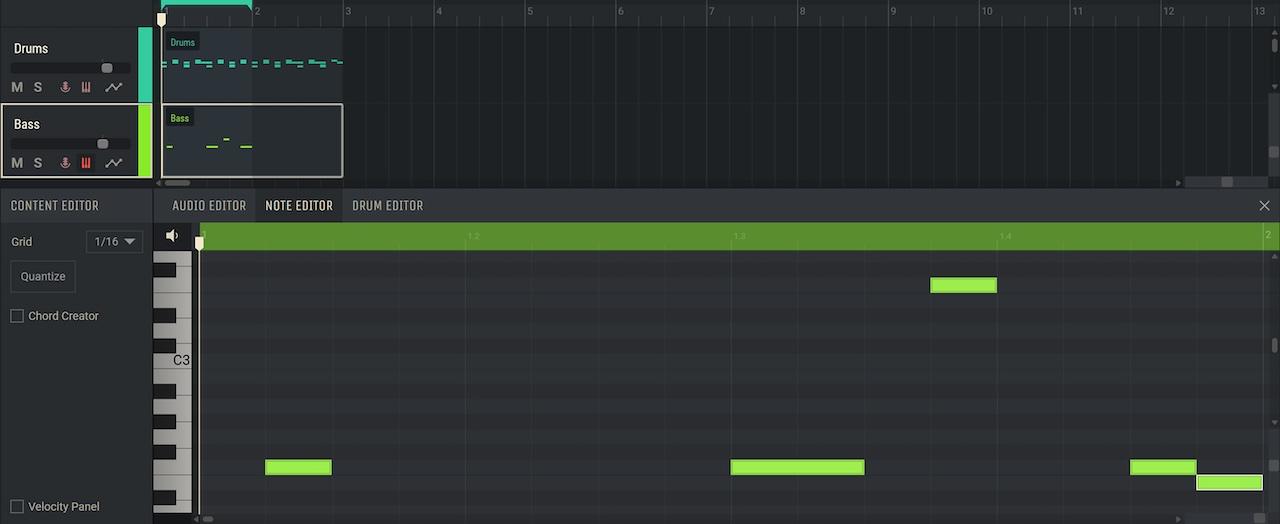
Arranging Your House Track
Understanding how to arrange a house track comes down to working with loop-based structures. House music isn’t about verse/chorus but about hypnotic repetition with variation.
And while it’s impossible to pin down a single “correct” house song structure, there are some essential building blocks that every producer works with. These are the sections you’ll piece together in your own way — and that’s where the real fun of creating house music begins, letting the groove rather than the rulebook lead you forward.
These are the building blocks that form the basic structure of house music:
- Intro: Just drums, maybe filtered chords fading in
- Part A: Your main loop.
- Part A variation: The same loop with added percussion, fills or FX.
- Part B: A development of Part A loop, this time with more significant changes — note variations, extra instrument layers, etc. The added layers should add energy to the initial loop.
- Breakdown: Drop out the heaviest elements of your main loop — the kick and the bass — to let the chords and vocals breathe.
- Drop: Full groove that slams back in after the breakdown with peak energy.
- Outro: Elements gradually stripped away.
These are the simplest arrangement building blocks that you will use to create house music by layering, subtracting, and experimenting. The artistry lies not in following formulas, but in shaping tension and release through the interplay of layers.

Bonus Tips & Tricks
Now that you’ve learned the basics of how to make a house track by constructing your basic starter loop, developing it and putting together the typical elements of a house track structure, let’s add some extra sauce. Check out these subtle house music production techniques that don’t rely on specific sounds or presets, but on arrangement moves that make a track unmistakably house.
- Soulful vocal samples are one of the genre’s trademarks. Both classic house anthems and modern productions often feature vocal snippets lifted from funk, disco and soul records.
- Percussion loops — congas, bongos, shakers — instantly add the swinging, soulful groove that’s hard to fake with programmed one-shots.
- A single sustained synth string note, held legato across an entire section, is a timeless house trick for building tension and signaling a transition without crowding the mix.
- Another way to signal an energy lift is to bring in a ride cymbal — either steady eighths or mirroring the open hi-hat — a subtle cue that the track is turning toward its next section.
Best Program for Making House Music?
Here’s the truth: the best program for making house music is the one you’ll actually use. Accessibility is key when you’re learning, which is why Amped Studio stands out as the best software to make house music for beginners because it runs entirely in your browser — no installation, no expensive hardware requirements, no complicated setup.
This makes it ideal if you’re creating house music for the first time or following an online house music production tutorial, since you can jump straight into experimenting without technical barriers. It’s a great tool for exploring how to make house beats quickly and intuitively.
Industry favorites like Ableton Live, FL Studio, and Logic Pro are excellent choices too, but they come with a price tag, a learning curve, and an involved installation process.
Final Thoughts
Making house music connects you to decades of dance floor history while giving you creative freedom to express yourself. The genre’s beauty lies in its apparent simplicity. Remember that the best house producers didn’t reinvent the wheel — they understood the blueprint deeply enough to make it their own. Every legendary house track started with someone laying down a kick drum and asking, “What makes me want to dance?”
Now it’s your turn. Open your browser, load up Amped Studio, and start building that groove.
FAQ
